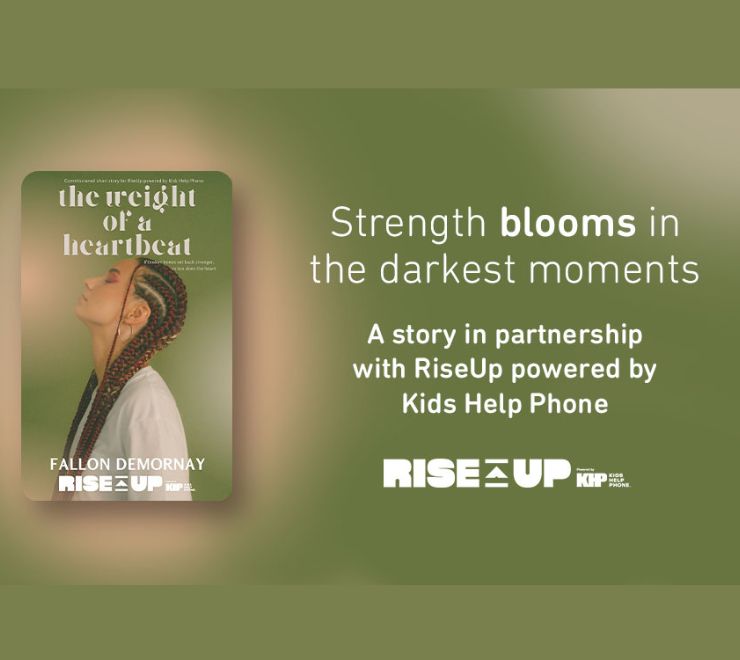Suicide is one of the most common topics that people reach out to Kids Help Phone about. Suicide can affect anyone in various ways – some people have thoughts of suicide, some know people who have thoughts of suicide, and some have experienced knowing someone who has died by suicide. It can be hard to understand why you or someone you know might have these thoughts. And, sharing how you’re feeling can be difficult if you’re worried about what other people might think. Here, Kids Help Phone provides information about factors that can contribute to suicide, warning signs, ways to prevent thoughts of suicide and tips to more openly talk about suicide.
If you’re currently having thoughts of suicide, it’s important to know that non-judgmental support is available. You can connect with a crisis responder through text or reach a Kids Help Phone counsellor by phone or Live Chat.
If you’re in crisis or in danger of taking action to end your life or harm yourself, you can connect with Kids Help Phone, call or text 9-8-8 (a 24/7 confidential national suicide crisis helpline), contact emergency services or a mobile crisis team in your area (if available) for immediate support.
What is suicide?
- Suicide is the intentional and voluntary act of someone ending their own life.
- Suicidal thoughts are when someone is thinking about ending their own life. The level and intensity of the thoughts can vary from one person to another, and many factors contribute to experiencing thoughts of suicide.
- A suicide attempt is when someone harms themselves with any intent to end their life, but they do not die as a result of their actions.
What factors contribute to thoughts of suicide?
Experiencing suicidal thoughts can feel painful, overwhelming and scary. Someone experiencing thoughts of suicide may feel hopeless, experience physical and/or emotional pain or feel like a burden to others. Having thoughts of suicide doesn’t necessarily mean that someone will end their life — many people have thoughts of suicide, but don’t end their lives. If you’re thinking about suicide, there are things you can do to cope.
Factors that can contribute to thoughts of suicide are complex and different for everyone. These are called risk factors because they may increase how likely someone is to experience thoughts of suicide. They can include:
- mental disorders or persistent/untreated mental health challenges
- family history of suicide
- loss of a friend, peer or community member to suicide
- exposure to trauma, violence and abuse
- experiences of bullying and cyberbullying
- chronic pain
- financial insecurity
- systemic inequities
- living with a disability
- experiences of discrimination and/or racism
- history of self-injury and/or previous suicide attempt(s)
- social isolation
- grief and loss
- inaccurate media reporting about suicide
- substance use
- going through a divorce/separation
The list above doesn’t account for everything, and there can be other things that contribute to thoughts of suicide. One factor and/or one specific event alone is rarely the reason someone ends their life. A person who’s thinking about suicide may have experienced one or some of the risk factors above throughout their life before developing thoughts of suicide. It’s important to note that experiencing one of these risk factors doesn’t automatically mean that a person will have thoughts of suicide. It’s also possible to experience thoughts of suicide and not have any of these risk factors.
Are some people at a higher risk of experiencing thoughts of suicide than others?
Some communities and groups of people can have a higher risk of developing thoughts of suicide. This is usually because of a combination of social, political and historical issues and injustices.
- Indigenous youth in some communities die by suicide at a higher rate due to ongoing discrimination and systemic racism, intergenerational trauma and the legacy of residential schools, unsafe housing, barriers to healthcare and culturally relevant support and other factors.
- 2SLGBTQ+ youth (transgender [trans] and non-binary youth in particular) are also at a higher risk of having thoughts of suicide or dying by suicide. This is because many 2SLGBTQ2S+ youth experience bullying, rejection by their families or peers, discrimination, violence and trauma.
- Statistics show that men and male-identified people also experience higher rates of suicide. This may be because society has told them/made them feel that men shouldn’t speak honestly and openly about their emotions.
Community plays an essential role in building connection and providing safe spaces to talk openly about thoughts of suicide. By educating yourself on suicide, you can become an important part of creating and contributing to a more supportive community.
What are the warning signs of suicide?
Thoughts of suicide can be expressed in many different ways. Like risk factors, they’re unique to each person. There are things that you may sense in yourself or learn about someone that could be warning signs.
You may notice:
- A change in mood (e.g. a loss of interest, irritability, rage, anxiety, hopelessness, prolonged sadness, carelessness, desperation, feelings of despair, etc.)
- A change in usual behaviour patterns (e.g. increased risky behaviour, significant changes to routine, isolating from others, giving away possessions, withdrawing from others, an increase in substance use, etc.)
- Thoughts expressing that death or dying is the only way to solve problems (e.g. “I’m a burden,” “No one will miss me when I’m gone,” “If I died then I wouldn’t have to deal with this,” “I want the pain to end,” “I wish I were dead,” “I wish I hadn’t been born,” “Dying is the only thing that will help,” etc.)
- Feelings of helplessness or hopelessness (e.g. “Things will never get better,” “Nothing matters anymore,” “I can’t do anything,” “I have no future,” “I can’t take anymore,” “I just want it all to go away,” etc.)
The thoughts and feelings listed above may not mean that someone is at immediate risk of dying by suicide. They may be a sign that you or someone you know is having challenges with their mental health and need support. If you or someone you know is experiencing feelings of hopelessness and/or suicidal thoughts, remember that help is available. You can reach out to Kids Help Phone’s professional counsellors and volunteer crisis responders for 24/7 mental health support.
Learn more about how to support someone with thoughts of suicide.
What factors can prevent suicide?
Many things can reduce how intensely and how often people experience thoughts of suicide — these are known as protective factors. While some of these factors may be part of your physical and/or social environment, it can be helpful to reflect on which factors you can work on or have control of. Understanding these factors and learning to recognize them is an important part of supporting the people around you and taking care of yourself.
Protective factors include:
- using different coping tools that work for you
- practising self-care
- adequate, accessible and culturally relevant care to support your physical, spiritual and emotional health
- a school, work and social environment that promotes well-being
- a strong and connected community — family, friends, places of worship or spiritual practice, etc.
- feeling a sense of belonging and safety
- having people to talk to and express your thoughts and feelings
- learning about different ways to improve your self-esteem
- a range of passions, interests and goals for the future
- having creative outlets to express your emotions (e.g. journaling prompts, self-awareness reflection and mindful colouring)
- getting enough sleep and taking care of your body through nutrition and movement
- financial security
- and others
Life Promotion
Some communities have introduced the idea of Life Promotion as an approach to preventing suicide. These two concepts are connected because what promotes life can help to reduce the risk of suicide. Created by Indigenous youth, Life Promotion focuses on the whole-person experience and recognizes the role of community and culture in suicide prevention efforts. Activities that promote Life Promotion can include land-based teachings, connections to Indigenous languages, ceremonial practice and more.
Everyone can play a role in reducing the stigma and shame around suicide. Creating an environment that’s supportive, empathetic and inclusive is an important part of preventing suicide.
How can I continue the conversation?
Educate yourself and others
Continue educating yourself on the complex causes of suicide. There are many stereotypes about suicide and mental health challenges (e.g. that people who attempt suicide are looking for attention, that people living with mental disorders are dangerous, etc.). These can negatively impact people who may be struggling and make it hard to reach out for support.
Research finds that talking openly and accurately about suicide can help those struggling feel less alone. Talking to people about suicide, in the context of care, respect and prevention does not increase the risk of suicidal thoughts or behaviours.
But we do have to be mindful of the language we use. For example, at one point in time, dying by suicide was illegal. As a result, people said “committing suicide”, which implies suicide is a crime. People who die by suicide are not criminals; they’re dealing with a difficult, painful situation. It’s best to use the terminology “die by suicide “or “end your life,” both of which are very direct but don’t come with any added stigma. Share this and other new things you learn with others!
Where can I find more information?
Self-reflect
Reflect on the attitudes/beliefs you hold around suicide and mental health. You can ask yourself questions like “Where did these ideas come from?”, “Are these ideas in line with my current values?”, “How might my beliefs affect others?” There’s always room to learn, grow and become a better supporter to those around you.
Show up
If you’re able to, show support for those who have lost loved ones to suicide and learn how you can help those experiencing thoughts of suicide. If you know someone is having a hard time, you can do things like bring them a meal, text/message/call them to let them know you’re thinking of them and support them in reaching out for help.
Suicide can affect anyone — if you or someone you know is experiencing thoughts of suicide, help is available. Kids Help Phone’s e-mental health services are available 24/7 for people across Canada. Taking the time to educate yourself on the signs of suicide, learn about protective factors and continue the conversation about suicide can also help reduce stigma and create a more caring and understanding community.














